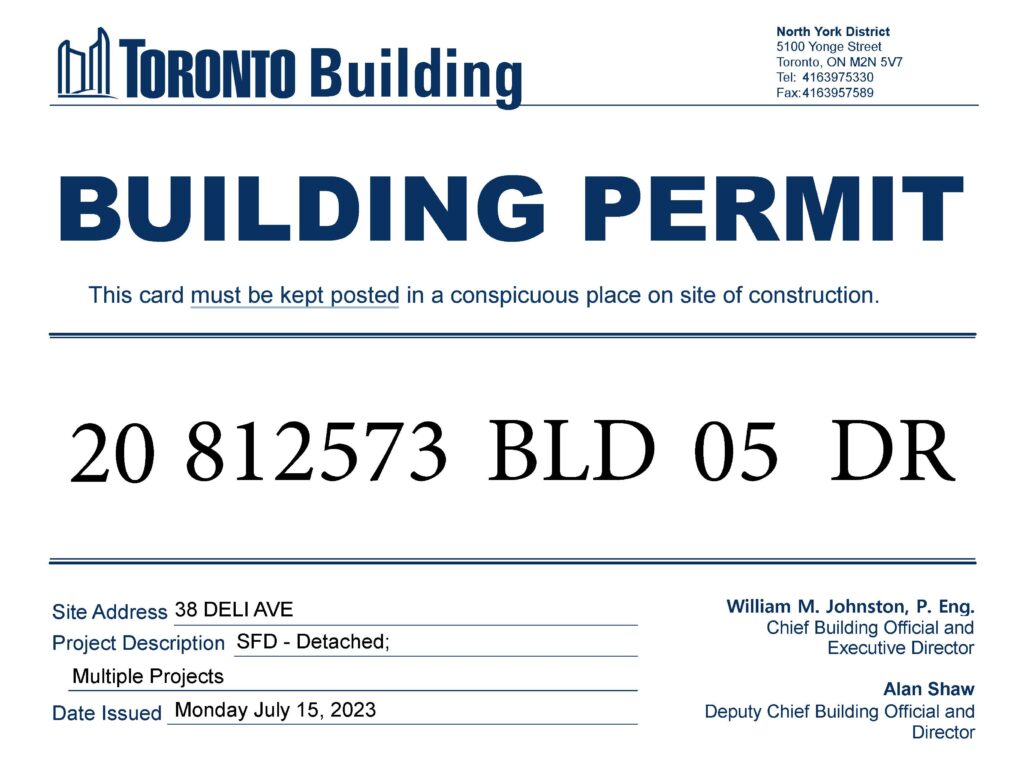
Deck and Porches Permit
Residential Permit Services
↳ Legal Basement Permit
↳ Decks and Porches Permit
↳ Demolition Permit
↳ Home Renovation Permit
↳ HVAC and Plumbing Permit
↳ Interior Alteration Permit
↳ Multiplex Permit
↳ New House Permit
↳ Pool and Gazebo Permit
↳ Re-zoning Permit
↳ Removing Load Bearing Wall Permit
↳ Walkout/Side Door Permit
↳ Small Addition Permit
↳ Tree Removal Permit
Deck Building Permits: What You Need to Know

In Toronto, Ontario, a building permit is required for a deck in order to guarantee structural integrity, safety, and adherence to local laws. By verifying that deck construction follows established building norms and safety requirements, these licenses are intended to protect homeowners and their neighbours. An extensive examination of the deck's construction and design plans is part of the permit procedure, which helps avert possible risks like overloading, collapses, and inadequate structural support. Moreover, getting a permit guarantees that the deck project conforms with environmental regulations, zoning rules, and other local criteria. Basically, having a construction permit for a deck in Toronto is more than just a formality; it's a way to protect the community's and the homeowner's safety, giving them piece of mind that the deck will be a safe and approved addition to their home.
You can trust Summit-Permit - Professional, Reliable, Affordable Design - Permit Drawings to help you obtain these necessary permits. Custom decks, pergolas, gazebos, pavilions, and accessory structures are their area of expertise. For a smooth and stress-free process, they also provide Fast Track Permit Application and City Administration services.
Understanding the Necessity of Deck Permits in Ontario
In Ontario, getting a deck permit is essential to guaranteeing the safety and compliance of your building project, not just a bureaucratic formality. In order to ensure that your deck is constructed in accordance with strict construction laws and safety standards and protects the homeowner and the community, deck permits are necessary. In addition, by ensuring that the deck conforms with environmental standards, zoning laws, and other municipal criteria, these licenses help to avoid potential dangers like overloading or structural failures. Furthermore, obtaining a deck permit is legally required and might spare you from future fines or the need to demolish non-compliant buildings.It protects your investment in a new deck and shows that you are committed to safe and responsible construction methods, which is advantageous for your home and the neighbourhood as a whole.
Gaining Insight into the Guidelines
Generally speaking, building a deck or porch that is joined to the main house or utilized in conjunction with an above-ground or below-ground structure calls for a building permit.
Although they do not need a building permit, uncovered decks that are not attached to the structure, are not larger than 10 M2 (108 ft2), and are less than 600 mm (24”) above the ground are still subject to City of Toronto zoning bylaws. A building permit is usually needed for covered decks and porches.
The majority of deck projects need a city permit. Regardless of whether you hire a professional to build the deck or if you do it yourself.
Porches and decks are very similar in construction. The main difference between the two is that a porch has a roof and is at least partially enclosed, while a deck is completely open. Zoning dictates how close your deck can be to a property line. A rear deck can be as near as 4 m (13 ft) to the back property line, and.6 m (2 ft) from a side property line in most neighbourhoods. Please get in touch with us to confirm the setbacks about your property, as there are some exceptions.
Decks and porches are constructed in quite similar ways. A porch has a roof and is at least partially enclosed, but a deck is entirely open. This is the primary distinction between the two.
Creating a deck is an artistic project that lets you turn your outdoor area into a useful and visually beautiful place. It's critical to get into the design phase knowing exactly how you want to use the deck. Think about your lifestyle and whether you want to host guests, unwind, eat, or do other things on the deck. Both your aesthetic tastes and these needs should be reflected in the design. To guarantee that the deck maximizes its usefulness and blends in with your home's current architecture, consider its size, shape, and layout. Railings, materials, and colour selections are just a few examples of elements that can be customized to fit your unique aesthetic and complement the overall design of your home.
Concrete Structural Design

There are a number of factors to take into account while picking the ideal location for your deck. Examine your property's geography and layout first and foremost. To ensure safety and convenience of building, choose a location that has a level and stable deck base. Consider solar exposure as well. Depending on the deck's position, it may receive less or more sunshine during the day. You might desire a covered location for comfort on hot summer days, or a sunny site for sunbathing, depending on your tastes.
Privacy is yet another important factor to think about. Evaluate the views from your home and consider how to make your deck feel private. This can be accomplished by building a fence, planting flowers, or positioning the deck in an area of your yard that provides plenty of natural seclusion. The comfort and usability of the deck may be impacted by wind patterns and natural ventilation, thus these factors should also be considered. You may build a deck that increases your outdoor living space and looks great with your house by carefully weighing all these elements and matching your design decisions with the site's features.
Getting a permit for a lake dock is an essential step in making sure that this type of building is compliant with local laws and takes safety and environmental concerns into account. Docks directly affect the surrounding lake ecology, regardless of whether they are used for private or commercial purposes. The proposed dock's size, layout, materials, and design are usually carefully considered by the permitting authorities in order to reduce any possible harm to the lake's ecology, water quality, and user safety. These rules sometimes include setback limits that dictate how far back the dock must be from the shoreline, nearby properties, and public access sites. Property owners can benefit from a waterfront structure and help maintain the lake's natural beauty and biological balance by getting a dock permit. It's a regulation designed to bring human activity and the fragile ecosystems of our beloved lakeshores together in harmony.
Navigating Zoning By-Laws: Deck Regulation

In Ontario, and especially in Toronto, zoning by-laws are essential for controlling the design and building of decks on both residential and commercial properties. By requiring decks to be built in a way that doesn't negatively impact the neighbourhood, these bylaws are crucial for preserving the peace and integrity of the community. Important factors include the allowable size and height of decks, setbacks from property lines, and other particular criteria like railing heights and clearances are governed by zoning restrictions. They also take into consideration the possible effects on nearby homes, protecting privacy and avoiding view obstruction. In addition to being required by law, observing these bylaws helps promote responsible development and neighbourhood aesthetics, guaranteeing that decks enhance Toronto's many neighbourhoods' overall identity. To stay out of legal trouble and maintain a peaceful urban environment, property owners must be aware of and abide by certain zoning restrictions.
Building Sturdy and Stunning Decks: Deck Building in a Variety of Canadian Environments
The connections between deck components are essential to the design of the deck because they control the structure's overall integrity, stability, and safety. The main elements of the deck are broken down here along with how they relate:

1. Foundation: To provide the necessary support, a deck's foundation usually comprises of concrete piers or sonotubes that are firmly fixed into the earth. For the weight to be distributed equally, the piers and the deck's structure must be connected properly.
2. Framing: Beams, joists, and ledger boards make up a deck's framing. Beams support the joists crucially and go perpendicular to the home. Since ledger boards are fastened directly to the house, it is essential to the integrity of the structure that they are connected to. Joists support the decking material and run parallel to the house.
3. Decking: The deck's visible surface is called the decking material, and it can be composed of PVC, composite, or wood. Securing the decking to the joists properly guarantees a level and safe surface. Different fasteners, such as screws, nails, or hidden clips, may be utilized, depending on the material.
4. Railings: Railings are both aesthetically pleasing and safe. Usually, they are fastened to the deck's structure with sturdy bolts. To prevent lateral forces and guarantee safety, the railing posts' attachment to the deck needs to be sturdy.
5. Stairs: Should your deck have stairs, they must be built properly, with each step fastened firmly to the stringers and the stringers fastened firmly to the deck's frame.
6. Fasteners and Hardware: Using the right fasteners and hardware, such as screws, nails, brackets, and hangers, is essential to building a deck correctly. These connections are necessary to guarantee that every part is firmly fastened and strong enough to support the weight and forces applied to the deck.
7. Ledger Connection: To stop water infiltration, the ledger board, which fastens the deck to the house, needs to be correctly flashed. Ledger board attachment is usually accomplished with lag bolts or structural screws, and the proper placement and spacing of these fasteners is essential to avoiding ledger failure.
8. Beam-to-Joist and Post-to-Beam Connections: These connections are critical for shifting the deck's weight from the beams to the joists and from the posts to the beams. Post caps and hangers are examples of the appropriate hardware that is utilized to form these connections securely.
For a deck to be safe and long-lasting, the connections between these parts must be carefully planned and implemented. Following regional building rules and best practices is essential to creating a deck that is not only aesthetically pleasing but also resilient to the elements.
Seeking Approval After Completing the Design

The issuance of your deck permit signifies the completion of a significant milestone in putting your outdoor vision into action. The time has arrived for the approval of your project and its compliance with local building codes and regulations in Toronto, Ontario, Canada. You have secured approval to start construction, which permits you with a sense of assurance. It's important to keep in mind that the project is not completely stress-free once the permit has been issued. During the construction process, it is important to comply with the conditions and specifications of the permit, including safety measures and the approved design. Inspections by local building authorities can be carried out at different stages to ensure that everything is running smoothly.
Getting in touch with Summit-Permit, located in Toronto and operated by the city of Ontario Canada, can result in an effortless process that saves you a lot of time. The permitting process is handled by Summit-Permit, who are experienced in the details and can quickly and efficiently manage the process for you. Their responsibility is to ensure that all paperwork is in order, expedite approvals are granted quickly, and comply with permit requirements so that your project can proceed smoothly.
This method not only minimizes delays but also ensures that your dream deck will be achieved without any unnecessary hassle. Obtaining the permit is a significant accomplishment, but diligent management and adhering to issued regulations can make the journey to your desired deck smoother and more efficient in Toronto, Ontario, Canada with Summit-Permit's assistance.

